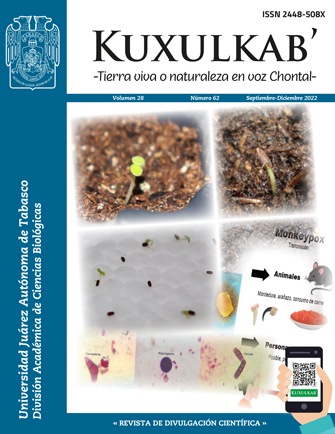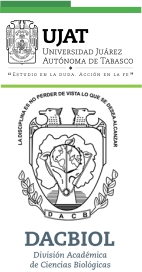PRESENCIA DE POLÍMEROS EN MAMÍFEROS MARINOS
MICROPLÁSTICOS RECURRENTES Y SUS CARACTERÍSTICAS
DOI:
https://doi.org/10.19136/kuxulkab.a28n62.5277Palabras clave:
Microplásticos, Mamíferos marinos, Tracto gastrointestinal, Heces, FibrasResumen
La presencia de microplásticos en el ambiente acuático propicia que la fauna adquiera estos materiales de forma directa o indirecta a través de los alimentos, principalmente. Los mamíferos marinos no son la excepción y debido a su gran tamaño son susceptibles a adquirir microplásticos. Este estudio busca definir qué tipo de polímeros están presentes en los mamíferos y que distribución tienen en función de sus propiedades, como color, morfología, tamaño y tipo de polímero reportados en los últimos cuatro años y siete meses (cincuenta y cinco meses). Se observó que, compuestos como polipropileno, polietileno tereftalato y polietileno están presentes en la mayoría de los mamíferos marinos. Los colores dominantes de estos microplásticos llegan a ser negro, azul, incoloro, verde, gris, entre otros. Con base en la morfología dominan las fibras y fragmentos en un rango de tamaño que varía entre 100-20,000 µm para fibras y de 44-40,000 µm para fragmentos, respectivamente.
Descargas
Referencias
Alexiadou, P.; Foskolos, I. & Frantzis, A. (2019). Ingestion of macroplastics by odontocetes of the Greek Seas, Eastern Mediterranean: Often deadly!. Marine Pollution Bulletin, 146: 67–75. https://doi.org/10.1016/J.MARPOLBUL.2019.05.055
Ayala, F.; Cardeña, M. & Cárdenas-Alayza, S. (2021). Registro preliminar de microplásticos en fecas del león marino sudamericano (“Otaria byronia” [de Blainville 1820]) recolectadas en punta San Juan, Perú. Revista Internacional de Contaminación Ambiental, 37: 273–279. https://doi.org/10.20937/RICA.53745
Banerjee, A. & Shelver, W.L. (2021). Micro- and nanoplastic induced cellular toxicity in mammals: A review. The Science of the Total Environment, 755(Pt 2). https://doi.org/10.1016/j.scitotenv.2020.142518
Battaglia, F.M.; Beckingham, B.A.; & McFee, W.E. (2020). First report from North America of microplastics in the gastrointestinal tract of stranded bottlenose dolphins (“Tursiops truncatus”). Marine Pollution Bulletin, 160: 111677. https://doi.org/10.1016/j.marpolbul.2020.111677
Besseling, E.; Foekema, E.M.; Van Franeker, J.A.; Leopold, M.F.; Kühn, S.; Bravo Rebolledo, E.L.; Heße, E.; Mielke, L.; IJzer, J.; Kamminga, P. & Koelmans, A.A. (2015). Microplastic in a macro filter feeder: Humpback whale “Megaptera novaeangliae”. Marine Pollution Bulletin, 95(1): 248–252. https://doi.org/10.1016/j.marpolbul.2015.04.007
Bradney, L.; Wijesekara, H.; Palansooriya, K.N.; Obadamudalige, N.; Bolan, N.S.; Ok, Y.S.; Rinklebe, J.; Kim, K.H. & Kirkham, M.B. (2019). Particulate plastics as a vector for toxic trace-element uptake by aquatic and terrestrial organisms and human health risk. Environment International, 131: 18. https://doi.org/10.1016/J.ENVINT.2019.104937
Brydson, J. (1999). Plastics Materials. In: Analysis and Deformulation of Polymeric Materials (Seventh ed). Springer. https://doi.org/10.1007/0-306-46908-1_8
Butterworth, A. & Sayer, S. (2017). The Welfare Impact on Pinnipeds of Marine Debris and Fisheries. Marine Mammal Welfare, 17: 215–239. https://doi.org/10.1007/978-3-319-46994-2_13
Carbery, M.; O’Connor, W. & Palanisami, T. (2018). Trophic transfer of microplastics and mixed contaminants in the marine food web and implications for human health. Environment International, 115: 400–409. https://doi.org/10.1016/J.ENVINT.2018.03.007
Castañeta, G.; Gutiérrez, A.F.; Nacaratte, F. & Manzano, C.A. (2020). Microplásticos: un contaminante que crece en todas las esferas ambientales, riesgos para la salud pública por exposición. Revista Boliviana de Química, 37(3): 160–175. https://doi.org/10.34098/2078-3949.37.3.4
Courtene-Jones, W.; Quinn, B.; Gary, S.F.; Mogg, A.O.M. & Narayanaswamy, B.E. (2017). Microplastic pollution identified in deep-sea water and ingested by benthic invertebrates in the Rockall Trough, North Atlantic Ocean. Environmental Pollution, 231: 271–280. https://doi.org/10.1016/j.envpol.2017.08.026
D’Agostino, F.; Bellante, A.; Quinci, E.; Gherardi, S.; Placenti, F.; Sabatino, N.; Buffa, G.; Avellone, G.; Di Stefano, V. & Del Core, M. (2020). Persistent and Emerging Organic Pollutants in the Marine Coastal Environment of the Gulf of Milazzo (Southern Italy): Human Health Risk Assessment. Frontiers in Environmental Science, 8: 117. https://doi.org/10.3389/FENVS.2020.00117/BIBTEX
Donohue, M.J.; Masura, J.; Gelatt, T.; Ream, R.; Baker, J.D., Faulhaber, K. & Lerner, D.T. (2019). Evaluating exposure of northern fur seals, “Callorhinus ursinus”, to microplastic pollution through fecal analysis. Marine Pollution Bulletin, 138: 213–221. https://doi.org/10.1016/j.marpolbul.2018.11.036
Dool, T. & Bosker, T. (2022). Predicted microplastic uptake through trophic transfer by the short-beaked common dolphin (“Delphinus delphis”) and common bottlenose dolphin (“Tursiops truncatus”) in the Northeast Atlantic Ocean and Mediterranean Sea. Marine Pollution Bulletin, 180: 113745. https://doi.org/10.1016/j.marpolbul.2022.113745
Dudek, K.L.; Cruz, B.N.; Polidoro, B. & Neuer, S. (2020). Microbial colonization of microplastics in the Caribbean Sea. Limnology and Oceanography Letters, 5(1): 5–17. https://doi.org/10.1002/LOL2.10141
Eriksson, C. & Burton, H. (2003). Origins and biological accumulation of small plastic particles in fur seals from Macquarie Island. Ambio, 32(6): 380–384. https://doi.org/10.1579/0044-7447-32.6.380
Erni-Cassola, G.; Zadjelovic, V.; Gibson, M.I. & Christie-Oleza, J.A. (2019). Distribution of plastic polymer types in the marine environment; A meta-analysis. Journal of Hazardous Materials, 369: 691–698. https://doi.org/10.1016/j.jhazmat.2019.02.067
Fossi, M.C.; Coppola, D.; Baini, M.; Giannetti, M.; Guerranti, C.; Marsili, L.; Panti, C.; de Sabata, E. & Clò, S. (2014). Large filter feeding marine organisms as indicators of microplastic in the pelagic environment: The case studies of the Mediterranean basking shark (“Cetorhinus maximus”) and fin whale (“Balaenoptera physalus”). Marine Environmental Research, 100: 1–8. https://doi.org/10.1016/j.marenvres.2014.02.002
Friot, D. & Boucher, J. (2017). Primary microplastics in the oceans | IUCN Library System (C.G. Lundin, J.M. de Sousa & Francis (eds.)). IUCN, Gland, Switzerland. https://doi.org/dx.doi.org/10.2305/IUCN.CH.2017.01.en Julien
Galloway, T.S. & Lewis, C.N. (2016). Marine microplastics spell big problems for future generations. Proceedings of the National Academy of Sciences of the United States of America, 113(9): 2331–2333. https://doi.org/10.1073/pnas.1600715113
Galloway, T.S.; Cole, M. & Lewis, C. (2017). Interactions of microplastic debris throughout the marine ecosystem. Nature Ecology & Evolution, 1(5): 1–8. https://doi.org/10.1038/s41559-017-0116
García Piqueras, M. & Torres Gavilá, J. (2021). Clínica y sanidad de odontocetos y pinnípedos en cautividad y vida libre. Nereis, 13. 187–202. https://doi.org/10.46583/NEREIS_2021.13
Gobierno de los Estados Unidos Mexicanos. (2010). Norma Oficial Mexicana NOM-059-SEMARNAT-2010, Protección ambiental-Especies nativas de México de flora y fauna silvestres-Categorías de riesgo y especificaciones para su inclusión, exclusión o cambio-Lista de especies en riesgo (p. 78). Diario Oficial de la Federación − Secretaria de Gobernación; Secretaría de Medio Ambiente y Recursos Naturales (SEMARNAT). https://www.dof.gob.mx/normasOficiales/4254/semarnat/semarnat.htm
Hale, R.C.; Seeley, M.E.; La Guardia, M.J.; Mai, L. & Zeng, E.Y. (2020). A global perspective on microplastics. Journal of Geophysical Research: Oceans, 125(1): 1–40. https://doi.org/10.1029/2018JC014719
Hearle, J.W.S. (2001). High-Performance Fibres - 1st Edition (J. W. S. Hearle (ed.); 1st Edition). Woodhead Publishing. https://www.elsevier.com/books/high-performance-fibres/hearle/978-1-85573-539-2
Hermida, É. (2011). Capítulo 9: Polímeros. En: Crowe C. (Ed.), Colección Materiales y materias primas (Vol. 2, p. 70). http://www.inet.edu.ar/wp-content/uploads/2012/11/09_Polimeros.pdf
Hernandez-Gonzalez, A.; Saavedra, C.; Gago, J.; Covelo, P.; Santos, M.B. & Pierce, G.J. (2018). Microplastics in the stomach contents of common dolphin (“Delphinus delphis”) stranded on the Galician coasts (NW Spain, 2005–2010). Marine Pollution Bulletin, 137: 526–532. https://doi.org/10.1016/j.marpolbul.2018.10.026
Hernandez-Milian, G.; Lusher, A.; MacGabban, S. & Rogan, E. (2019). Microplastics in grey seal (“Halichoerus grypus”) intestines: Are they associated with parasite aggregations?. Marine Pollution Bulletin, 146: 349–354. https://doi.org/10.1016/j.marpolbul.2019.06.014
Hocking, D.P.; Marx, F.G.; Park, T.; Fitzgerald, E.M.G. & Evans, A.R. (2017). Reply to comment by Kienle et al. 2017. Proceedings of the Royal Society B: Biological Sciences, 284(1863). https://doi.org/10.1098/rspb.2017.1836
Hossain, M.S.; Rahman, M.S.; Uddin, M.N.; Sharifuzzaman, S.M.; Chowdhury, S.R.; Sarker, S. & Nawaz Chowdhury, M.S. (2019). Microplastic contamination in Penaeid shrimp from the Northern Bay of Bengal. Chemosphere, 238: 124688. https://doi.org/10.1016/j.chemosphere.2019.124688
Houck, M.M. (2009). Ways of identifying textile fibers and materials. Identification of Textile Fibers: 6–26. https://doi.org/10.1533/9781845695651.1.6
Huang, P.; Su, Y.; Luo, H.; Lan, X.; Chong, Y.; Wu, F. & Zheng, W. (2022). Facile one-step method to manufacture polypropylene bead foams with outstanding thermal insulation and mechanical properties via supercritical CO2 extrusion foaming. Journal of CO2 Utilization, 64: 102167. https://doi.org/10.1016/j.jcou.2022.102167
IUCN (International Union for Conservation of Nature). (2022). Red List of Threatened Species. https://www.iucnredlist.org/
Julienne, F.; Lagarde, F.; Bardeau, J.F. & Delorme, N. (2022). Thin polyethylene (LDPE) films with controlled crystalline morphology for studying plastic weathering and microplastic generation. Polymer Degradation and Stability, 195: 109791. https://doi.org/10.1016/J.POLYMDEGRADSTAB.2021.109791
Kiran, B.R.; Kopperi, H. & Venkata Mohan, S. (2022). Micro/nano-plastics occurrence, identification, risk analysis and mitigation: challenges and perspectives. Reviews in Environmental Science and Biotechnology, 21(1): 169–203. https://doi.org/10.1007/S11157-021-09609-6/TABLES/3
Koltzenburg, S.; Maskos, M. & Nuyken, O. (2017). Polymer chemistry. In: Polymer Chemistry. Springer Berlin Heidelberg. https://doi.org/10.1007/978-3-662-49279-6/COVER
Koongolla, J.B.; Lin, L.; Pan, Y.F.; Yang, C.P.; Sun, D.R.; Liu, S.; Xu, X.R.; Maharana, D.; Huang, J.S. & Li, H.X. (2020). Occurrence of microplastics in gastrointestinal tracts and gills of fish from Beibu Gulf, South China Sea. Environmental Pollution (Barking, Essex: 1987), 258: 26. https://doi.org/10.1016/J.ENVPOL.2019.113734
Lehtiniemi, M.; Hartikainen, S.; Näkki, P.; Engström-Öst, J.; Koistinen, A. & Setälä, O. (2018). Size matters more than shape: Ingestion of primary and secondary microplastics by small predators. Food Webs, 16: e00097. https://doi.org/10.1016/j.fooweb.2018.E00097
Lei, X.; Cheng, H.; Luo, Y.; Zhang, Y.; Jiang, L.; Sun, Y.; Zhou, G. & Huang, H. (2021). Abundance and characteristics of microplastics in seawater and corals from Reef Region of Sanya Bay, China. Frontiers in Marine Science, 8: 1–10. https://doi.org/10.3389/fmars.2021.728745
Liu, S.; Chen, H.; Wang, J.; Su, L.; Wang, X.; Zhu, J. & Lan, W. (2021). The distribution of microplastics in water, sediment, and fish of the Dafeng River, a remote river in China. Ecotoxicology and Environmental Safety, 228: 113009. https://doi.org/10.1016/j.ecoenv.2021.113009
Lusher, A.L.; Hernandez-Milian, G.; Berrow, S.; Rogan, E. & O’Connor, I. (2017). Incidence of marine debris in cetaceans stranded and by caught in Ireland: Recent findings and a review of historical knowledge. Environmental Pollution, 232: 467–476. https://doi.org/10.1016/J.ENVPOL.2017.09.070
Mager Stellman, J. (1998). Parte XIV – Industrias textiles y de la confección. En: Enciclopedia de Salud y Seguridad en el Trabajo (“Encyclopaedia of Occupational Health and Safety”, Ministerio de Trabajo y Asuntos Sociales (Trad).; 4ta edición; capítulos 87-90). Oficina Internacional del Trabajo (Ginebra). Chantal Dufresne, BA. https://www.insst.es/documentacion/material-tecnico/enciclopedia-oit/tomo-iii
Martin, C.; Baalkhuyur, F.; Valluzzi, L.; Saderne, V.; Cusack, M.; Almahasheer, H.; Krishnakumar, P.K.; Rabaoui, L.; Qurban, M.A.; Arias-Ortiz, A.; Masqué, P. & Duarte, C.M. (2020). Exponential increase of plastic burial in mangrove sediments as a major plastic sink. Science Advances, 6(44): 1–8. https://doi.org/10.1126/SCIADV.AAZ5593
Martín, J.; Santos, J.L.; Aparicio, I. & Alonso, E. (2022). Microplastics and associated emerging contaminants in the environment: Analysis, sorption mechanisms and effects of co-exposure. Trends in Environmental Analytical Chemistry, 35: 15. https://doi.org/10.1016/J.TEAC.2022.E00170
Marzocchi, V. a.; Beldoménico, H.R. & Vanzetti, N.A. (2011). Bifenilos policlorados: relación entre estructura química, parámetros conformacionales y toxicidad efecto-dioxina. Avances en Ciencias e Ingeniería, 2(4): 109–118. https://dialnet.unirioja.es/servlet/articulo?codigo=3815195&info=resumen&idioma=ENG
Mastandrea, C.; Chichizola, C.; Ludueña, B.; Sánchez, H.; Álvarez, H. & Gutiérrez, A. (2005). Hidrocarburos aromáticos policíclicos. Riesgos para la salud y marcadores biológicos, 39(0325–2957): 27–36. http://www.scielo.org.ar/scielo.php?pid=S0325-29572005000100006&script=sci_arttext&tlng=pt
Miller, M.E.; Hamann, M. & Kroon, F.J. (2020). Bioaccumulation and biomagnification of microplastics in marine organisms: A review and meta-analysis of current data. PLOS ONE, 15(10): 25. https://doi.org/10.1371/JOURNAL.PONE.0240792
Moody, V. & Needles, H.L. (2004). 1. Fiber Theory and Formation. In: Tufted Carpet: Textile Fibers, Dyes, Finishes and Processes (pp. 3–21). William Andrew Publishing. https://doi.org/10.1016/B978-188420799-0.50002-6
Moore, R.C.; Loseto, L.; Noel, M.; Etemadifar, A.; Brewster, J.D.; MacPhee, S.; Bendell, L. & Ross, P.S. (2019). Microplastics in beluga whales (“Delphinapterus leucas”) from the Eastern Beaufort Sea. Marine Pollution Bulletin, 150: 110723. https://doi.org/10.1016/j.marpolbul.2019.110723
Moore, R.C.; Noel, M.; Etemadifar, A.; Loseto, L.; Posacka, A.M.; Bendell, L. & Ross, P.S. (2021). Microplastics in beluga whale (“Delphinapterus leucas”) prey: An exploratory assessment of trophic transfer in the Beaufort Sea. Science of The Total Environment, 806: 150201. https://doi.org/10.1016/j.scitotenv.2021.150201
Nelms, S.E.; Barnett, J.; Brownlow, A.; Davison, N.J.; Deaville, R.; Galloway, T.S.; Lindeque, P.K.; Santillo, D. & Godley, B.J. (2019). Microplastics in marine mammals stranded around the British coast: ubiquitous but transitory? Scientific Reports, 9(1): 1–8. https://doi.org/10.1038/s41598-018-37428-3
Nelms, S.E.; Galloway, T.S.; Godley, B.J.; Jarvis, D.S. & Lindeque, P.K. (2018). Investigating microplastic trophic transfer in marine top predators. Environmental Pollution, 238: 999–1007. https://doi.org/10.1016/j.envpol.2018.02.016
NOAA (National Oceanic and Atmospheric Administration). (2021). Biomagnification. https://oceanexplorer.noaa.gov/edu/learning/player/lesson13/l13la1.html
Novillo, O.; Raga, J.A. & Tomás, J. (2020). Evaluating the presence of microplastics in striped dolphins (“Stenella coeruleoalba”) stranded in the Western Mediterranean Sea. Marine Pollution Bulletin, 160: 111557. https://doi.org/10.1016/j.marpolbul.2020.111557
Panti, C.; Baini, M.; Lusher, A.; Hernandez-Milan, G.; Bravo Rebolledo, E.L.; Unger, B.; Syberg, K.; Simmonds, M.P. & Fossi, M.C. (2019). Marine litter: One of the major threats for marine mammals. Outcomes from the European Cetacean Society workshop. Environmental Pollution, 247: 72–79. https://doi.org/10.1016/j.envpol.2019.01.029
Perez-Venegas, D.J.; Seguel, M.; Pavés, H.; Pulgar, J.; Urbina, M.; Ahrendt, C. & Galbán-Malagón, C. (2018). First detection of plastic microfibers in a wild population of South American fur seals (“Arctocephalus australis”) in the Chilean Northern Patagonia. Marine Pollution Bulletin, 136: 50–54. https://doi.org/10.1016/j.marpolbul.2018.08.065
Perez-Venegas, D.J.; Toro-Valdivieso, C.; Ayala, F.; Brito, B.; Iturra, L.; Arriagada, M.; Seguel, M.; Barrios, C.; Sepúlveda, M.; Oliva, D.; Cárdenas-Alayza, S.; Urbina, M.A.; Jorquera, A.; Castro-Nallar, E. & Galbán-Malagón, C. (2020). Monitoring the occurrence of microplastic ingestion in Otariids along the Peruvian and Chilean coasts. Marine Pollution Bulletin, 153(August 2019): 110966. https://doi.org/10.1016/j.marpolbul.2020.110966
Pinzone, M.; Nordøy, E.S.; Eppe, G.; Malherbe, C.; Das, K. & Collard, F. (2021). First record of plastic debris in the stomach of a hooded seal pup from the Greenland Sea. Marine Pollution Bulletin, 167: 6. https://doi.org/10.1016/J.MARPOLBUL.2021.112350
Pironti, C.; Ricciardi, M.; Motta, O.; Miele, Y.; Proto, A. & Montano, L. (2021). Microplastics in the environment: Intake through the food web, human exposure and toxicological effects. Toxics, 9(9): 224. https://doi.org/10.3390/TOXICS9090224
Rosal, R. (2021). Morphological description of microplastic particles for environmental fate studies. Marine Pollution Bulletin, 171: 112716. https://doi.org/10.1016/j.marpolbul.2021.112716
Samal, K.; Mahapatra, S. & Hibzur Ali, M. (2022). Pharmaceutical wastewater as emerging contaminants (EC): Treatment technologies, impact on environment and human health. Energy Nexus, 6: 100076. https://doi.org/10.1016/J.NEXUS.2022.100076
Sathish, M.N.; Jeyasanta, I. & Patterson, J. (2020). Occurrence of microplastics in epipelagic and mesopelagic fishes from Tuticorin, Southeast coast of India. Science of the Total Environment, 720: 9. https://doi.org/10.1016/j.scitotenv.2020.137614
Schwarzer, M.; Brehm, J.; Vollmer, M.; Jasinski, J.; Xu, C.; Zainuddin, S.; Fröhlich, T.; Schott, M.; Greiner, A.; Scheibel, T. & Laforsch, C. (2022). Shape, size, and polymer dependent effects of microplastics on “Daphnia magna”. Journal of Hazardous Materials, 426: 9. https://doi.org/10.1016/J.JHAZMAT.2021.128136
Scircle, A.; Cizdziel, J.V.; Missling, K.; Li, L. & Vianello, A. (2020). Single-Pot method for the collection and preparation of natural water for microplastic analyses: Microplastics in the Mississippi River system during and after historic fooding. Environmental Toxicology and Chemistry, 39(5): 986–995. https://doi.org/10.1002/ETC.4698
Shapiro, K.; Krusor, C.; Mazzillo, F.F.M.; Conrad, P.A.; Largier, J.L.; Mazet, J.A.K. & Silver, M.W. (2014). Aquatic polymers can drive pathogen transmission in coastal ecosystems. Proceedings of the Royal Society B: Biological Sciences, 281(1795): 9. https://doi.org/10.1098/RSPB.2014.1287
Sharifinia, M.; Bahmanbeigloo, Z.A.; Keshavarzifard, M.; Khanjani, M.H. & Lyons, B.P. (2020). Microplastic pollution as a grand challenge in marine research: A closer look at their adverse impacts on the immune and reproductive systems. Ecotoxicology and Environmental Safety, 204: 111109. https://doi.org/10.1016/J.ECOENV.2020.111109
Stockin, K.A.; Pantos, O.; Betty, E.L.; Pawley, M.D.M.; Doake, F.; Masterton, H.; Palmer, E.I.; Perrott, M.R.; Nelms, S.E. & Machovsky-capuska, G.E. (2021). Fourier transform infrared (FTIR) analysis identifies microplastics in stranded common dolphins (“Delphinus delphis”) from New Zealand waters. Marine Pollution Bulletin, 173: 113084. https://doi.org/10.1016/j.marpolbul.2021.113084
Sun, T.; Wu, H.; Wang, X.; Ji, C.; Shan, X. & Li, F. (2020). Evaluation on the biomagnification or biodilution of trace metals in global marine food webs by meta-analysis. Environmental Pollution, 264: 11. https://doi.org/10.1016/J.ENVPOL.2019.113856
Thompson, R.C.; Olsen, Y.; Mitchell, R.P.; Davis, A.; Rowland, S.J.; John, A.W.G.; McGonigle, D. & Russell, A.E. (2004). Lost at Sea: Where Is All the Plastic? Science, 304(5672): 838. https://doi.org/10.1126/SCIENCE.1094559/SUPPL_FILE/THOMPSON.SOM.PDF
Tierney, K.B.; Farrell, A.P. & Brauner, C.J. (2013). Organic chemical toxicology of fishes (K. Tierney, A. Farrell & C. Brauner (eds.)). https://www.elsevier.com/books/fish-physiology-organic-chemical-toxicology-of-fishes/tierney/978-0-12-398254-4
Tsakona, M.; Baker, E.; Rucevska, I.; Thomas Maes, L.; Appelquist, R.; Macmillan-Lawler, M.; Peter Harris, K.; Raubenheimer, L.R.; Savelli-Soderberg, H.; Ohno, K.W.; Dittkrist, J.; Zwimpfer, T.A.; Aidis, R.; Mafuta, C. & Schoolmeester, T. (2021). Drowning in Plastics – Marine Litter and Plastic Waste Vital Graphics (report; p. 77). United Nations Environment Programme (UNEP); Secretariats of the Basel; Rotterdam and Stockholm Conventions (BRS) and GRID-Arendal. https://www.unep.org/resources/report/drowning-plastics-marine-litter-and-plastic-waste-vital-graphics
van Franeker, J.A.; Bravo Rebolledo, E.L.; Hesse, E.; Ijsseldijk, L.L.; Kühn, S.; Leopold, M. & Mielke, L. (2018). Plastic ingestion by harbour porpoises “Phocoena phocoena” in the Netherlands: Establishing a standardised method. Ambio, 47(4): 387–397. https://doi.org/https://doi.org/10.1007/s13280-017-1002-y
Windsor, F.M.; Tilley, R.M.; Tyler, C.R. & Ormerod, S.J. (2019). Microplastic ingestion by riverine macroinvertebrates. Science of The Total Environment, 646: 68–74. https://doi.org/10.1016/J.SCITOTENV.2018.07.271
Wright, S.L.; Thompson, R.C. & Galloway, T.S. (2013). The physical impacts of microplastics on marine organisms: A review. Environmental Pollution, 178: 483–492. https://doi.org/10.1016/J.ENVPOL.2013.02.031
Xiong, X.; Chen, X.; Zhang, K.; Mei, Z.; Hao, Y.; Zheng, J.; Wu, C.; Wang, K.; Ruan, Y.; Lam, P.K.S. & Wang, D. (2018). Microplastics in the intestinal tracts of East Asian finless porpoises (“Neophocaena asiaeorientalis sunameri”) from Yellow Sea and Bohai Sea of China. Marine Pollution Bulletin, 136: 55–60. https://doi.org/10.1016/j.marpolbul.2018.09.006
Zantis, L.J.; Carroll, E.L.; Nelms, S.E. & Bosker, T. (2021). Marine mammals and microplastics: A systematic review and call for standardisation. Environmental Pollution, 269. 116142. https://doi.org/10.1016/j.envpol.2020.116142
Zeisler, R.; Demiralp, R.; Koster, B.J.; Becker, P.R.; Burow, M.; Ostapczuk, P. & Wise, S.A. (1993). Determination of inorganic constituents in marine mammal tissues. Science of The Total Environment, 139–140(C): 365–386. https://doi.org/10.1016/0048-9697(93)90034-4
Zhang, Z.; Deng, C.; Dong, L.; Liu, L.; Li, H.; Wu, J. & Ye, C. (2021). Microplastic pollution in the Yangtze River Basin: Heterogeneity of abundances and characteristics in different environments. Environmental Pollution, 287. https://doi.org/10.1016/J.ENVPOL.2021.117580
Zhu, J.; Yu, X.; Zhang, Q.; Li, Y.; Tan, S.; Li, D.; Yang, Z. & Wang, J. (2019). Cetaceans and microplastics: First report of microplastic ingestion by a coastal delphinid, “Sousa chinensis”. Science of The Total Environment, 659: 649–654. https://doi.org/10.1016/j.sccitotenv.2018.12.389
Zobkov, M.B. & Esiukova, E.E. (2018). Microplastics in a Marine Environment: Review of Methods for Sampling, Processing, and Analyzing Microplastics in Water, Bottom Sediments, and Coastal Deposits. Oceanology, 58(1): 137–143. https://doi.org/10.1134/S0001437017060169
Descargas
Publicado
Número
Sección
Licencia
Derechos de autor 2022 Kuxulkab'

Esta obra está bajo una licencia internacional Creative Commons Atribución-NoComercial-CompartirIgual 4.0.
Los autores que publiquen en Kuxulkab' aceptan las siguientes condiciones como política de acceso abierto:
1. Que conservan los derechos de autor y ceden a la revista el derecho de la primera publicación, con el trabajo registrado con la licencia de atribucion de "Creative Commons", que permite a terceros utilizar lo publicado siempre que mencionen la autoría del trabajo y a la primera publicación en esta revista.
2. El autor puede realizar otros acuerdos contractuales independientes o adicionales para la distribución no exclusiva de la versión del artículo publicado en esta revista, como por ejemplo incluirlo en un repositorio institucional o publicarlo en un libro, siempre que se indique claramente que el trabajo se publicó por primera vez en esta revista.













